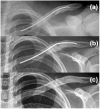Operative Treatment of Adolescent Diaphyseal Clavicle Fracture: Elastic Stable Intramedullary Nail Versus Plate Fixation
- PMID: 40870539
- PMCID: PMC12388430
- DOI: 10.3390/medicina61081494
Operative Treatment of Adolescent Diaphyseal Clavicle Fracture: Elastic Stable Intramedullary Nail Versus Plate Fixation
Abstract
Background and Objectives: Adolescent diaphyseal clavicle fracture surgery has increased in recent years. However, the optimal operative method remains debated, particularly between elastic stable intramedullary nailing (ESIN) and plate fixation. This study compared postoperative outcomes and complication rates between ESIN and plate fixation for treating diaphyseal clavicle fractures in adolescent patients. Materials and Methods: We conducted a retrospective review of 35 adolescents who underwent surgery for diaphyseal clavicle fractures between 2010 and 2024. Patients were assigned to either the ESIN group (n = 18) or the plate fixation group (n = 17). Postoperative outcomes assessed included the Quick Disabilities of the Arm, Shoulder, and Hand (QuickDASH) score, intraoperative time, time to complete fracture union, and clavicle shortening at 1 year postoperatively. Postoperative complications were also evaluated. Results: Fracture union occurred significantly faster with ESIN than with plate fixation, specifically 3 weeks earlier (11.0 weeks vs. 14.0 weeks; p < 0.001). No significant differences were observed between the groups in QuickDASH scores, intraoperative time, or clavicle shortening at 1 year. The overall postoperative complication rate was 25.7% (9/35), with no statistically significant difference between the ESIN (27.8%) and plate fixation groups (23.5%) (p = 0.774). Refractures occurred exclusively in the plate fixation group (n = 2), while one patient in the ESIN group required early nail removal due to insertion site irritation. Conclusions: ESIN provided functional and radiographic outcomes comparable to plate fixation in adolescents with diaphyseal clavicle fractures, with a 3-week shorter time to union and a less-invasive surgical approach.
Keywords: adolescent; diaphyseal clavicle fracture; elastic stable intramedullary nail; plate fixation.
Conflict of interest statement
The authors declare no conflicts of interest.
Figures




Similar articles
-
Surgical interventions for treating acute fractures or non-union of the middle third of the clavicle.Cochrane Database Syst Rev. 2015 May 7;2015(5):CD007428. doi: 10.1002/14651858.CD007428.pub3. Cochrane Database Syst Rev. 2015. PMID: 25950424 Free PMC article.
-
Multicenter, Prospective, Observational Study of Nonoperative Versus Operative Treatment for High-Energy Midshaft Clavicle Fractures.J Orthop Trauma. 2024 Jul 1;38(7):345-350. doi: 10.1097/BOT.0000000000002817. J Orthop Trauma. 2024. PMID: 38837208
-
Comparison of hook plates vs. locking plates for Neer type IIB fractures of lateral end clavicle: A systematic review.Chin J Traumatol. 2025 Jul;28(4):269-275. doi: 10.1016/j.cjtee.2024.03.012. Epub 2025 Feb 19. Chin J Traumatol. 2025. PMID: 40087117 Free PMC article.
-
[Surgical Treatment of Clavicle Midshaft Fractures - Prospective Randomized Trial].Acta Chir Orthop Traumatol Cech. 2020;87(2):101-107. Acta Chir Orthop Traumatol Cech. 2020. PMID: 32396510 Clinical Trial. Czech.
-
[Comparative study on effectiveness of clavicular hook plate fixation in treatment of acromioclavicular joint dislocation and distal clavicle fractures].Zhongguo Xiu Fu Chong Jian Wai Ke Za Zhi. 2025 Aug 15;39(8):1037-1044. doi: 10.7507/1002-1892.202504077. Zhongguo Xiu Fu Chong Jian Wai Ke Za Zhi. 2025. PMID: 40830131 Free PMC article. Chinese.
References
-
- Ellis H.B., Li Y., Bae D.S., Kalish L.A., Wilson P.L., Pennock A.T., Nepple J.J., Willimon S.C., Spence D.D., Pandya N.K., et al. Descriptive Epidemiology of Adolescent Clavicle Fractures: Results From the FACTS (Function after Adolescent Clavicle Trauma and Surgery) Prospective, Multicenter Cohort Study. Orthop. J. Sports Med. 2020;8:2325967120921344. doi: 10.1177/2325967120921344. - DOI - PMC - PubMed
MeSH terms
LinkOut - more resources
Full Text Sources
Medical

